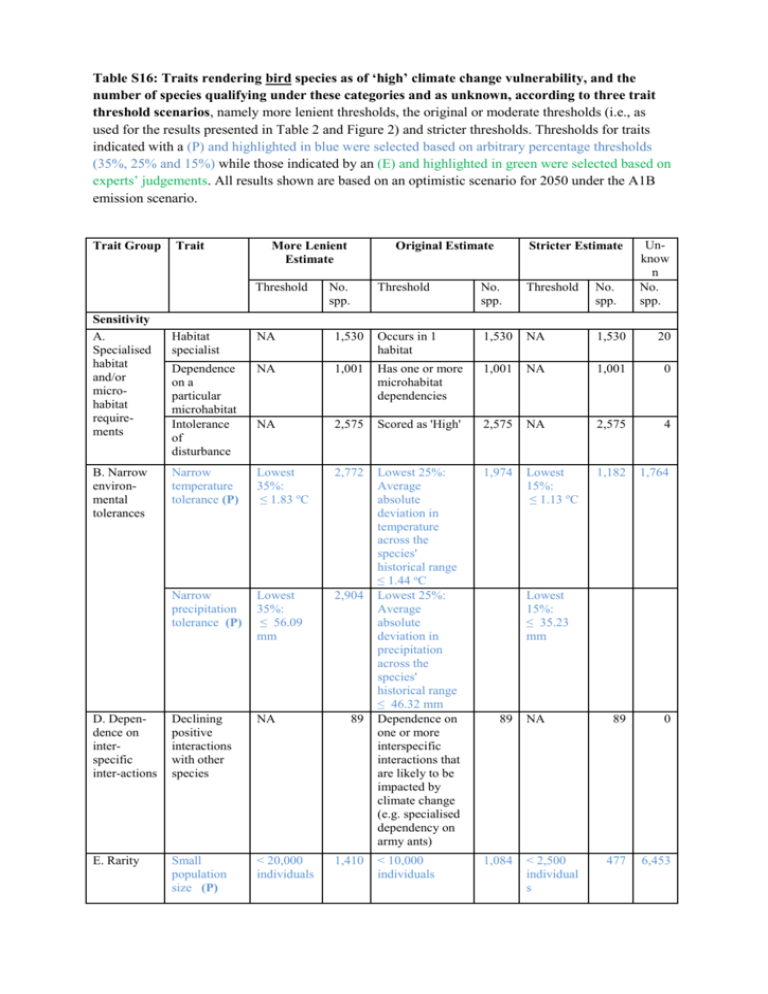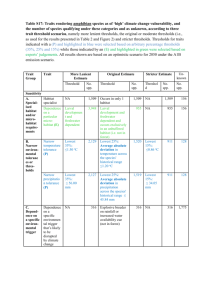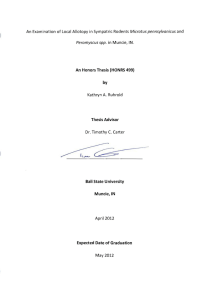Table S16: Traits rendering bird species as of `high` climate change
advertisement

Table S16: Traits rendering bird species as of ‘high’ climate change vulnerability, and the number of species qualifying under these categories and as unknown, according to three trait threshold scenarios, namely more lenient thresholds, the original or moderate thresholds (i.e., as used for the results presented in Table 2 and Figure 2) and stricter thresholds. Thresholds for traits indicated with a (P) and highlighted in blue were selected based on arbitrary percentage thresholds (35%, 25% and 15%) while those indicated by an (E) and highlighted in green were selected based on experts’ judgements. All results shown are based on an optimistic scenario for 2050 under the A1B emission scenario. Trait Group Trait More Lenient Estimate Threshold Sensitivity A. Specialised habitat and/or microhabitat requirements Original Estimate No. spp. Stricter Estimate Threshold No. spp. Threshold No. spp. Unknow n No. spp. Habitat specialist NA 1,530 Occurs in 1 habitat 1,530 NA 1,530 20 Dependence on a particular microhabitat Intolerance of disturbance NA 1,001 Has one or more microhabitat dependencies 1,001 NA 1,001 0 NA 2,575 Scored as 'High' 2,575 NA 2,575 4 Narrow temperature tolerance (P) Lowest 35%: ≤ 1.83 oC 2,772 1,974 Lowest 15%: ≤ 1.13 oC 1,182 1,764 Narrow precipitation tolerance (P) Lowest 35%: ≤ 56.09 mm 2,904 D. Dependence on interspecific inter-actions Declining positive interactions with other species NA Lowest 25%: Average absolute deviation in temperature across the species' historical range ≤ 1.44 oC Lowest 25%: Average absolute deviation in precipitation across the species' historical range ≤ 46.32 mm Dependence on one or more interspecific interactions that are likely to be impacted by climate change (e.g. specialised dependency on army ants) E. Rarity Small population size (P) < 20,000 individuals < 10,000 individuals 1,084 B. Narrow environmental tolerances 89 1,410 Lowest 2 15%: , ≤0 35.23 mm 9 5 89 NA < 2,500 individual s 1 , 2 7 9 1 , 7 6 4 89 0 477 6,453 Small population size and heightened sensitivity to threatening processes (E) < 50,000 and [(skewed sex ratio) OR (polygyno us or polyandro us breeding system) OR (cooperative breeding system) OR (declining or extremely fluctuating population trend)] 1,423 Maximum intrinsic dispersal distance <=1.5 km/year NA 2,628 < 20,000 and [(skewed sex ratio) 1,410 < 10,000 and [(skewed sex ratio) OR (polygyno us or polyandro us breeding system) OR (cooperative breeding system) OR (declining or extremely fluctuatin g popn trend)] 869 6,453 1,993 Maximum intrinsic dispersal distance <= 0.5 km/year NA 1,510 0 700 0 69 0 OR (polygynous or polyandrous breeding system) OR (cooperative breeding system) OR (declining or extremely fluctuating population trend)] Low adaptive capacity A. Poor dispersability Low intrinsic dispersal capacity (E) Extrinsic barriers to dispersal B. Poor evolva-bility Exposure A. Sea level rise B. Changes in temp- 700 Low genetic diversity NA Slow turnover of generations (P) Low reproductive capacity (P) Generation length ≥ 5.7 years 2,809 Mean clutch size: ≤ 2.5 3,288 Habitat types exposed to sea level inundation (E) Occurs largely in inundation exposed coastal habitats and up to 2 other habitat types Highest 35%: 425 Substantial changes in 69 2,735 Maximum intrinsic dispersal distance <= 1 km/year Occurs exclusively on mountaintops, small islands and/or polar edges of land masses Evidence of low genetic diversity or known genetic bottleneck Generation length ≥ 6 years Mean clutch size: ≤ 2 Occurs largely in inundation exposed coastal habitats and up to 1 other habitat type Highest 25%: Absolute 700 69 NA 2,500 Generatio n length ≥ 8 years 1,196 0 2,414 Mean clutch size: ≤ 1.5 749 3,496 163 Occurs in inundatio n exposed coastal habitats only 42 20 1,097 1,869 1,921 Highest 15%: erature C. Changes in precipitation mean temperature occur across the species' range (P) ≥ 2.1 oC Substantial changes in temperature variability across the species' range (P) Highest 35%: ≥ 1.0 oC 2,668 Substantial changes in mean precipitation occur across the species' range (P) Highest 35%: ≥ 0.38 2,738 Substantial changes in precipitation variability across the species' range (P) Highest 35%: ≥ 0.23 2,959 difference between (mean temperatures across the species' range for all months) from 1975-2050 ≥ 2.5 oC Highest 25%: Absolute difference between (average absolute deviation in temperatures across the species' range for all months) from 1975 to 2050 ≥ 1.2 oC Highest 25%: Absolute ratio of change in (mean precipitation across the species' range for all months) from 1975 to 2050 ≥ 0.49 Highest 25%: Absolute ratio of change in (average absolute deviation in precipitation across the species' range for all months) from 1975 to 2050 ≥ 0.33 ≥ 3.1 oC 1,925 Highest 15%: ≥ 1.6 oC 1,144 1,869 1,998 Highest 15%: ≥ 0.61 1,233 1,869 2,152 Highest 15%: ≥ 0.52 1,351 1,869










